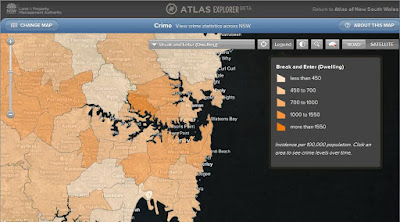All the information is presented as a series of thematic map overlays in four categories:
- People (eg. population, health, housing, religion, indigenous population, indexes of relative advantage/disadvantage, crime);
- Economy (eg. labour force, taxation and revenue, and production of fruit and vegetables, oils and grins, and livestock);
- History (eg. information on settlement, State elections and boarders); and
- Environment (including vegetation, geology and soils, and locations of national parks).
Users have a choice between satellite image or roads map as a base layer and can adjust transparency level of thematic overlays. Each overlay is accompanied by a comprehensive legend, explaining the meaning of presented data. A click on individual region brings up a pop-up window with information about the region, presented as charts and gauges.

The Atlas of New South Wales is quite responsive considering the amount of data that is required to present thematic overlays. It would benefit though from a bit more legible charts and access to source data in a tabular format and/ or for download. Overall, the application is well built and very simple to navigate through.




